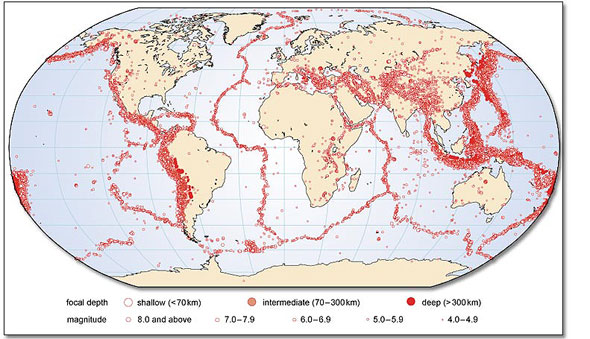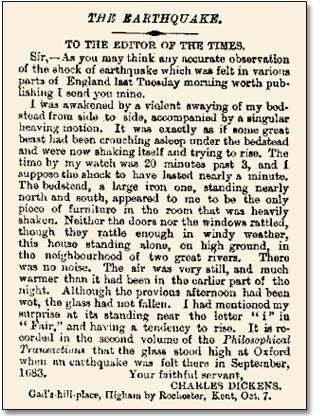3 Where do earthquakes occur?
How deep in the Earth do earthquakes occur? Most earthquake foci are within a few tens of kilometres of the surface. Earthquakes less than 70 km deep are classified as shallow-focus. Earthquakes with foci 70–300 km deep are classified as intermediate-focus and those below 300 km are deep-focus (Figure 7). Shallow-focus earthquakes occur more often than deeper ones; about 75% of the total energy released from earthquakes is from shallow-focus ones. Unfortunately, the shallower an earthquake, the more damage it can produce at the surface; intermediate and deep-focus earthquakes are rarely destructive. No earthquakes are known to have occurred below about 700 km. At greater depths the rocks are very hot and under high pressure so they deform by flowing rather than breaking and faulting.
Do earthquakes occur everywhere, or only in some parts of the Earth? So far, this unit has discussed earthquakes in Japan and California, and in the Pacific Ocean near Alaska and near Peru. You may also recall hearing of earthquakes in Italy, Armenia, Mexico City, China and even Britain. Figure 7 shows the global distribution of earthquakes.

Figure 7 Global earthquake epicentres for 1980–1996. Shallow-focus earthquakes are white circles, intermediate-focus earthquakes are light red circles and deep-focus earthquakes are deep red circles. Only earthquakes of magnitude 4 and above are included. Data from the British Geological Survey World Seismicity Database, Global Seismology and Geomagnetism Group, Edinburgh. (>means ‘greater than’; < means ‘less than’.)
Activity 1 Comparing information on different maps of the Earth
- (a) Use Figure 7 to describe the main patterns of the geographical distribution of earthquakes.
- (b) Use Figure 7 and the poster map to identify which surface features on the Earth appear to have (i) shallow, and (ii) deep earthquakes associated with them.
Answer
(a) Earthquakes are not distributed evenly across the Earth's surface, so it does not seem sensible to describe the pattern simply as a variation from west to east across the map. The fact that earthquakes occur in distinct regions is reflected in the answer given below:
Earthquakes are concentrated in specific regions of the Earth, and they often occur in linear belts or arcs. One belt surrounds the Pacific Ocean, including Japan, Alaska and the western coast of North, Central and South America. Another region is from southeastern Europe through the Middle East and the Himalayan Mountains. There are also earthquakes in linear zones in the oceans.
The decision to structure the answer in this way was made after looking at Figure 7. If the question had asked you to look at a different map and describe the variation of something different, such as population, you would probably have ordered your answer in a different way (possibly continent by continent) so as to give the most logical answer.
(b) In this part, the planning involved looking at two very different maps and noting their different scales and projections. (Try to get into the habit of looking to see if a scale has been given whenever you look at a map or a diagram, and also to put a scale on any diagrams you produce so that other people looking at them will understand what you are depicting.) Comparing Figure 7 with the poster leads to the following conclusions about the relationship between shallow and deep-focus earthquakes and surface features:
- (i) Shallow-focus earthquakes appear to be associated with mid-ocean ridges, with mountain ranges in the interior of the continents of Europe and Asia, and with the mountains and ocean trenches that surround the Pacific Ocean.
- (ii) Deep-focus earthquakes appear to be associated mainly with the mountains and ocean trenches that surround the Pacific Ocean (for example, near the coast of South America, or the coast of Japan).
Earthquakes are largely confined to specific areas of the Earth, called seismic zones (derived from seismos, the Greek word for ‘shaking’). Most of the rest of the Earth is relatively free of earthquakes, or at least free of large earthquakes (Figure 7). However, even the UK has some small earthquakes (Box 3, Earthquakes in the UK).
Box 3 Earthquakes in the UK
Earthquakes do occur in and around the UK, but they are usually fairly small; the largest one recorded (in 1931) had about a thousand times less energy than the 1906 San Francisco earthquake, for example. This 1931 earthquake occurred under the North Sea but was felt over most of the UK. Two earthquakes just a little smaller occurred in the Dover Straits in 1382 and 1580, causing significant damage in London, the latter killing two apprentices in Newgate. In 1863, Charles Dickens experienced shaking caused by an earthquake and was moved to write to The Times describing its effects (Figure 8).
All UK earthquakes occur at shallow depths; the greatest recorded depth is 42 km.
You will have seen in Activity 1 that most earthquakes are associated with certain features of the Earth's solid surface – mid-ocean ridges, ocean trenches, and some mountain belts. We can also see that deeper earthquakes are characteristic of ocean trenches whereas shallower earthquakes are more typical of mid-ocean ridges. This relationship between the surface features of the Earth, and the movement of blocks of the Earth that causes earthquakes, is one of the observations of the active Earth that can be explained by the theory of plate tectonics. For now, however, we will continue looking specifically at earthquakes.

